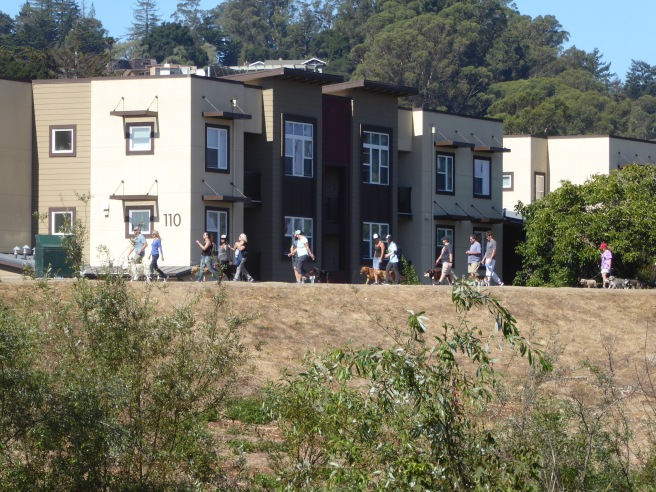Hi Jane,
My, how good it feels to walk along the river again after two weeks in New York City and Baltimore. It is so true that a person needs a sense of place. I felt a very comforting rush of well-being as I eased back onto the River and began to take in all the familiar landmarks and birds.
You can imagine that three juvenile PIED-BILLED GREBES swimming in and out among the tules under the Water St. Bridge especially called to me! I read later that another birder on our river, Shantanu Phukan, had reported that he had seen four of these juveniles, all “incessantly begging for food”. Are there too few fish to satisfy these young ones? Or was this just normal begging behavior? I’ve been wondering why birds that fish for a living tend to hang out under bridges, in spite of the noisy traffic overhead. Could it be that the water is cooler under bridges and therefore more more attractive to fish?

The other surprise this week was the sight of a GREAT EGRET swooping dramatically down out of the sky and settling in some dense brush across from the Benchlands – a sight I had never seen before. This magnificent pure white creature managed to momentarily upstage the more common SNOWY EGRET, GREAT BLUE HERON AND GREEN HERON that more normally frequent my end of the river, and that were also there to welcome me back this week!

The AMERICAN COOTS aren’t back yet in the huge numbers that we saw last year. But I did count eighteen of them. Were they recently arrived back from the far north where they breed, or were these among the coots that hang out and breed all summer in other parts of the County. I wonder why they never choose our River as a breeding ground?
I spotted 2 GOLDEN-CROWNED SPARROWS and 13 WHITE-CROWNED SPARROWS along the Riverwalk on the east side of the levee between Highway 1 and Water St. These regular winter residents had definitely just arrived from northern Canada or Alaska where they breed. Reports of their appearance have just begun to pop up on eBird and MBB.
In all, I saw 31 species of birds this week. That number should grow dramatically in the next couple of months as more migrants arrive. Readers can check out my recent lists at http://ebird.org/ebird/view/checklist/S31587425
The keep-out signs that the City has recently installed all along the river seem to be working. I did breathe more easily to see the river banks free of people and trash. As an environmentalist I’m relieved to know that the birds will also breathe more easily. As a member of the human family, I wonder where the campers will sleep tonight. I hope they find a safe place. Incidentally, I heard from a friend that the stretch below Laurel is not posted. Are they protecting that stretch for paddlers? Paddling yes, sleeping no?

I’m not happy either about the new Paws in the Park program that the Coastal Watershed Council has dreamed up to ‘activate the Riverwalk’. I had initially thought that as long as dog-owners kept their dogs on leash and on the asphalt path, they did not pose a threat to wildlife. But when I mentioned it to our long time environmentalist friends Jean Brocklebank and Rachel O’Malley, Jean quickly told me that any dog is perceived as a predator simply by its scent. She also reminded me that dogs are not allowed in San Lorenzo Park. Is CWC getting another special waiver as they did in the paddling situation? Rachel, who is a professor of environmental science at San Jose State University, sent me several links to scholarly articles on the subject of the threat posed by dogs to wildlife, including leashed dogs. One of the articles she sent explored the effect of barking dogs on coots. It says,
“Animals frequently interrupt their activity to look up and to scan their surrounding environment for potential predators (vigilance). As vigilance and other activities are often mutually exclusive, such behaviours are at the expense of feeding, sleeping or preening. Authors of many wildlife disturbance studies found that people with free-running dogs provoked the most pronounced disturbances (e.g. greater flushing distances and more birds affected). However, dogs on leash may also negatively affect wild animals, and barking dogs may lead to an increase in vigilance. In this study, I tested this hypothesis in coots …Two main findings resulted from the study: (1) coots respond to acoustic traits of dogs and may be able to acoustically recognise this predator and (2) this increase in vigilance might have implications for conservation, especially when considering buffer zones around sensitive areas.”
I am very happy to see that CWC is now sponsoring invasive plant removal on the River. May we all one day live in harmony with each other and with nature.
Barbara
Thank you so much for your beautiful writing. I am looking forward to seeing the birds start to arrive.
LikeLike
Thanks for your kind note, Kimberly. It has been so rewarding for me to begin to understand the migratory rhythms – something I used to be oblivious to.
LikeLike